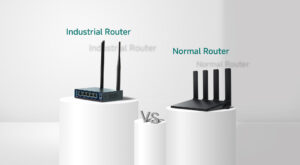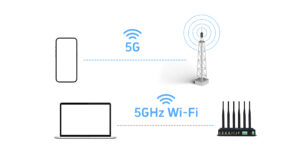In today’s fast-paced industrial environments, network reliability is critical. Whether in smart factories, remote oil fields, or automated warehouses, losing connectivity can mean costly downtime. This is where cellular access points come in—a game-changing solution that combines traditional Wi-Fi with 5G/4G LTE cellular backup to ensure uninterrupted operations.
What Is a Cellular Access Point?
A cellular WiFi access point (also called a cellular wireless access point) is a networking device that provides both Wi-Fi and cellular connectivity. Unlike standard access points that rely solely on wired broadband, these devices integrate 5G/4G LTE modules, allowing them to switch seamlessly between wired and cellular networks when the primary connection fails.
Key features of modern cellular access points include:
- Dual-network backup – Automatic failover between wired and cellular broadband.
- High-speed 5G connectivity – Utilizing 5G Sub-6GHz for IoT and eMBB (Enhanced Mobile Broadband) applications.
- Backward compatibility – Support for 4G LTE and 3G when 5G is unavailable.
- Wi-Fi 6 support – Faster speeds, lower latency, and better performance in high-density environments.
Why Industrial Applications Need Cellular Access Points
Industrial settings demand uninterrupted, high-bandwidth connectivity. Traditional Wi-Fi access points can fail due to fiber cuts, power outages, or interference. A 5G cellular access point solves this by providing:
1. Unmatched Reliability with Dual-Network Backup
- If the primary wired connection fails, the device automatically switches to 5G/4G cellular without disruption.
- Critical for SCADA systems, remote monitoring, and automated machinery.
2. High-Speed, Low-Latency 5G for Industrial IoT
- 5G NR (NSA & SA) support ensures ultra-fast data transfer for real-time analytics, AGVs (Automated Guided Vehicles), and AI-driven automation.
- The Qualcomm X62-based 5G module (used in leading models) delivers peak speeds and superior stability.
3. Future-Proof Connectivity
- 3GPP Release 16 compatibility ensures long-term support for evolving 5G standards.
- Wi-Fi 6 (802.11ax) enhances performance in crowded wireless environments.
Use Cases for Cellular Access Points in Industrial Networks
- Smart Manufacturing – Ensures real-time machine communication even if the main network goes down.
- Oil & Gas Remote Sites – Provides last-mile connectivity where wired infrastructure is unavailable.
- Transportation & Logistics – Keeps warehouse robots and tracking systems online 24/7.
- Utilities & Smart Grids – Enables failproof monitoring of substations and pipelines.
Choosing the Right Cellular Access Point
When selecting a cellular access point for industrial applications, consider:
- 5G vs. 4G LTE – 5G offers higher speeds, but 4G LTE may suffice for some use cases.
- Wi-Fi 6 support – Essential for high-density IoT deployments.
- Rugged design – Look for IP67-rated, wide-temperature-range models for harsh environments.
- Seamless failover – Ensure automatic switching between wired and cellular networks.
Leading solutions in this space (including some cutting-edge models like Come-Star CIAP716N-6A25 incorporate 5G M.2 modules, dual-network backup, and industrial-grade durability, making them ideal for mission-critical operations.
Final Thoughts
As industries embrace Industry 4.0, the demand for cellular internet access points will only grow. By combining Wi-Fi 6 and 5G cellular backup, these devices provide the redundancy, speed, and reliability that modern industrial networks require.
Whether you’re managing a smart factory, a remote mining site, or a large-scale logistics hub, a cellular wireless access point ensures that your operations stay connected—no matter what.


